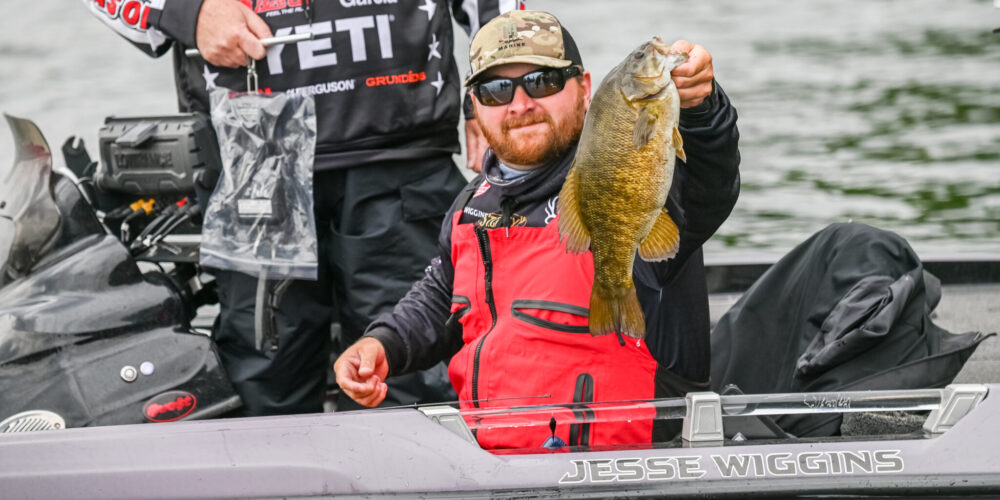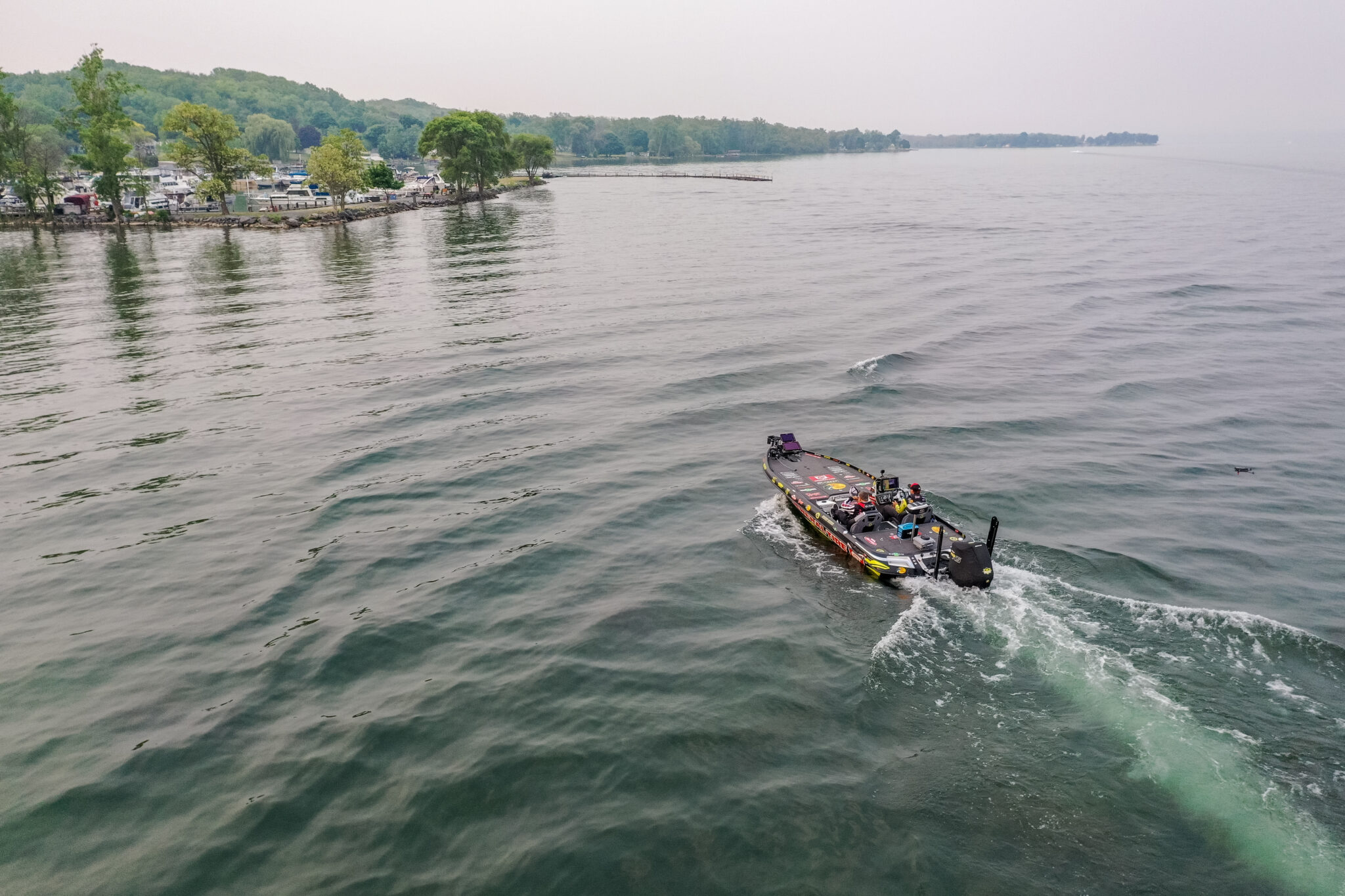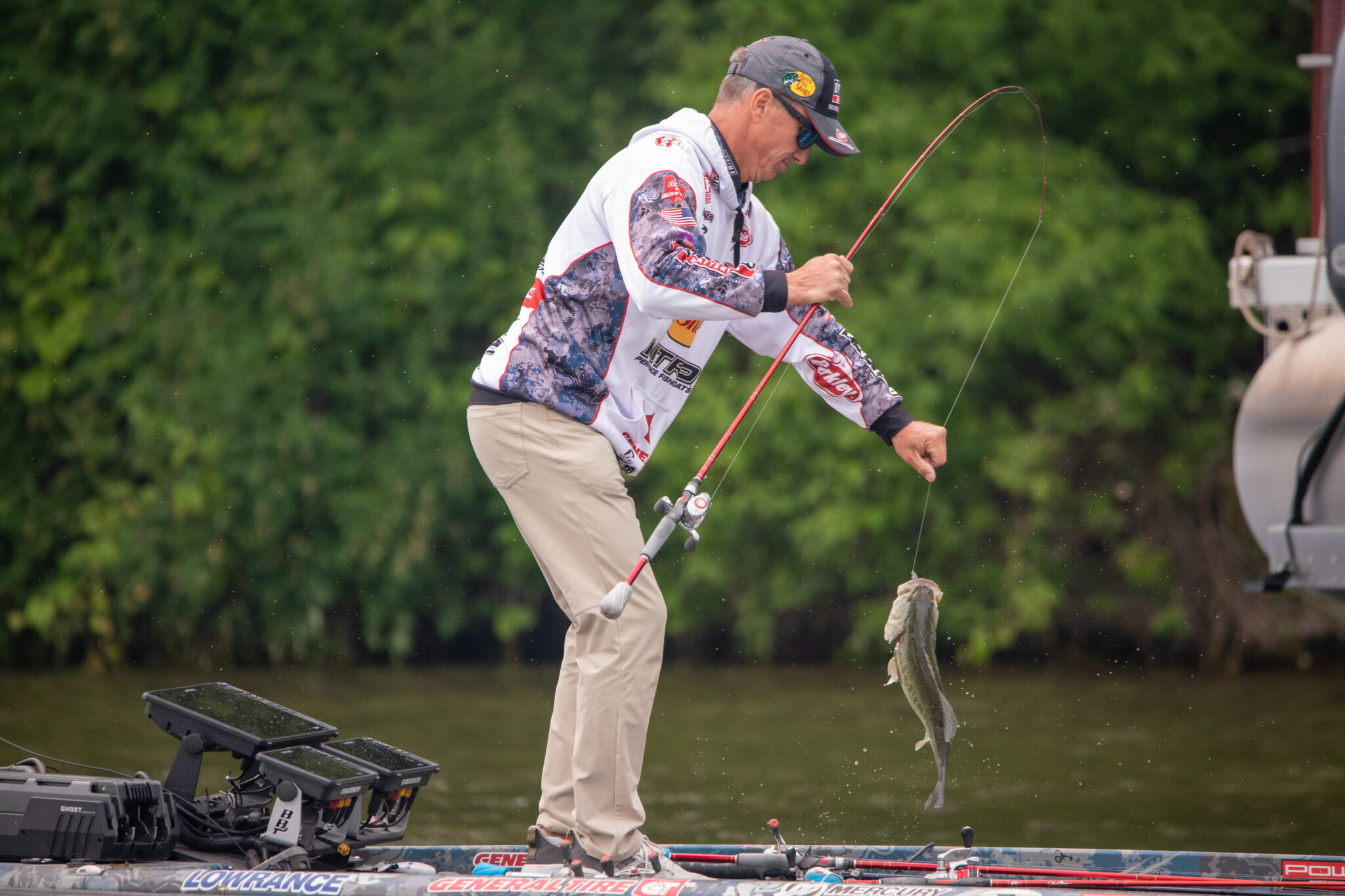Takeaways from Day 3 at Cayuga Lake
Smallmouth proving out, Wiggins, Reese rally, late-day surges

UNION SPRINGS, N.Y. – The second day of qualifying for Group A at Favorite Fishing Stage Five Presented by ATG by Wrangler on Cayuga Lake saw 20 anglers clinch their spots for what should be a no-holds-barred slugfest in Saturday’s Knockout Round.
It also indicated which of the two bass species the field will, primarily, be brawling over.
Entering the tournament, there was some question as to whether or not an angler could win by focusing solely on smallmouth bass, as Dustin Connell did when the BPT came to Cayuga last August. Local hammer Kraig Kettelkamp even predicted that largemouth would anchor the winning bag this time around.
But Thursday’s results suggest that, barring a drastic change in conditions or fish behavior, it’s going to be difficult for a largemouth angler to compete with the quality of smallmouth that live in Cayuga.
Through two days of competition for Group A, the top five anglers on SCORETRACKER® have weighed in almost exclusively smallmouth, the only exception being two Day 1 green fish in Dylan Hays’ bag.
While the largemouth fishing seemed to slow for several anglers on Thursday, big smallies continued to show up in abundance. Of the 12 anglers who sacked up more than 23 pounds, 10 filled their limits entirely with brown fish. Smallmouth comprised each of the nine heaviest bags of the day — despite the fact that the likes of Kevin VanDam, Connell and Jacob Wheeler, all of whom have spent the first two days of competition sight-fishing for smallies, put their rods down in the afternoon while they looked for fresh fish.
It shouldn’t surprise anyone to see Cayuga producing jumbo smallmouth. The New York state record was broken on the lake last June with an 8-pound, 6-ounce brute. But the prevailing thought coming into the event was that the less numerous smallmouth might get depleted during a six-day event, giving those fishing for largemouth, or a mixed bag, a better chance at prevailing.
Halfway through the tournament, the opposite appears to be true. Not only are Cayuga’s smallmouth heavier, on average, than its largemouth, they seem to be easier to catch consistently.
Each of the three anglers who started Thursday above the Toro Cut Line and fell outside the Top 20 — Luke Clausen, Fred Roumbanis and James Elam — caught only largemouth. Meanwhile, the two biggest upward movers of the day — Jesse Wiggins and Skeet Reese — both switched from catching all largemouth on Day 1 to all smallmouth on Day 2.
Perhaps the most telling numbers – on Tuesday, smallmouth accounted for 24% of the field’s total weight. That number increased to 31& on Wednesday and shot up to 48% Thursday.
MLF Fisheries Management Division biologist Steven Bardin isn’t surprised to see smallmouth leading the way. Given how the fish have ballooned in recent years, which Bardin attributes to the introduction of the invasive round goby, he assumed entering the tournament that the biggest five-fish stringers would consist of smallmouth.
“Largemouth might be more abundant, so they’ll make up more of the bags, but smallmouth, on average, have a better size class,” Bardin said. “So that’s exactly what you’re seeing. As we move to a five-fish limit and away from every fish counts, the guys that are targeting a better quality fish, they just happen to be smallmouth, they’re rising to the top.”
While the numbers indicate that largemouth are, indeed, more abundant — they have accounted for 68.9% of all fish caught through three days — Bardin believes the calendar also favors smallmouth fishing.
As those who have watched the action on MLFNOW! know, the vast majority of smallmouth caught so far have been sight-fished from spawning beds. Bardin believes it’s not quite warm enough for largemouth to lock down on their nests. As a result, quite a few of the green fish seem to be in limbo between full-blown prespawn, when they feed aggressively, and actually spawning.
“I would guess that what has happened is the smallmouth are further along in spawning season than the largemouth are,” Bardin said. “And so the largemouth, technically they spawn at slightly warmer temperatures, so those fish are in what we would call like prespawn mode. And, right before they get to the spawn, they do become more difficult to catch because they go from gorging themselves on food to trying to find nesting locations and things like that. They become more nomadic. So it’s probably easier to catch fish, smallmouth, on beds than it is to find nomadic largemouth that are prespawn.”
The other factor that can explain the shift toward smallmouth has nothing to do with the spawn. As anglers saw the weight VanDam and other smallmouth sight-fishermen were able to put on SCORETRACKER® during the first two days of competition, more opted to head south and emulate that strategy.
“When I put 28-1 on the scales, it opened everybody’s eyes the first day,” VanDam said. “And it got a lot of people sight-fishing for smallmouth that didn’t the first day.”
VanDam noted that he’s expecting the smallmouth water to be crowded during Saturday’s Knockout Round, which could slow the fishing a bit. But at least from a biological standpoint, Bardin believes the smallmouth action should only get better as the week progresses.
As the weather warms and the skies clear, prompting more fish to spawn and making sight-fishing easier, Bardin expects the smallmouth weights to get even bigger — perhaps even state-record size.
“This is exactly in line with what I expected,” Bardin said. “It actually may be a little bit light for those smallmouth. We’ve never had the opportunity to come to a world-class smallmouth fishery prespawn or right as the spawn is beginning and catch those fish whenever they’re full of eggs. They’ve gotten the gobies being introduced so they’re a better quality than they’ve ever been. Last year at this time, that’s when the new state record was caught. So my expectation is, you put 80 of the best anglers in the world on that same fishery at that same time, and I’m surprised we haven’t smashed the state record twice.”

Wiggins, Reese rally to make Knockout Round
Given how well Group A caught ‘em on Day 1, with 20 anglers topping 20 pounds, the 3-and-a-half pound deficit Wiggins faced compared to the Toro Cut Line and the 4-plus pound gap for Reese had to feel like swimming across the 1.5-mile width of Cayuga.
But both anglers shifted their strategies and used the lake’s meaty smallmouth to secure their spots in the Knockout Round.
Wiggins, who began the day in 30th place, immediately found a stretch of bank loaded with spawning smallies. He caught eight in the first period, with the best five weighing 24-7. He proceeded to upgrade throughout the day and finished with a limit of 26-4, placing him 12th in Group A.
Wiggins caught his fish on a combination of a drop shot and a hair jig. In all, he boated 16 fish, all of which were 4 pounds or bigger, for a grand total of 61-13. Talk about an epic day.
Reese didn’t match Wiggins in numbers, but he actually put together a heavier five-fish bag. The veteran caught five fish over 5 pounds to rocket from 31st place at the start of the day to 15th at the end. He used either a drop shot or a wacky worm to pluck the fish from their beds.

Evers, Sprague surge late
Among the anglers who struggled to make the largemouth cooperate for much of the day were Edwin Evers and Jeff Sprague. Both pros topped 20 pounds during the first day of competition but found themselves without a limit and beneath the Toro Cut Line at the start of the third period on Thursday.
Evers, who entered the week ranked second in the Bally Bet Angler of the Year standings, stuck to his guns and continued to skip his wacky-rigged Berkley MaxScent The General around boat docks on the northern end of the lake. His perseverance paid off. During the last two hours of competition, he caught largemouth weighing 5-11, 3-10 and 6-3. That gave him 21-3 for the day and lifted him to a sixth-place finish in the group.
Sprague, on the other hand, bailed on largemouth water to go join the smallmouth sight-fishermen. Even though he spent more than an hour failing to coax one bedding fish into biting, he managed to boat three smallmouth over 4 pounds, including a 4-10 and a 4-12 in the final 70 minutes of competition. Sprague’s 21-10 bag gave him a 14th-place finish and a spot in the Knockout Round.